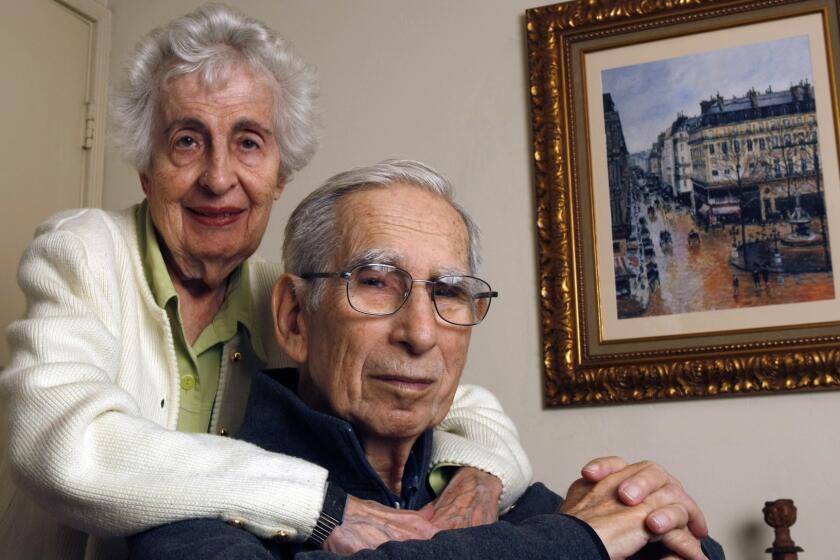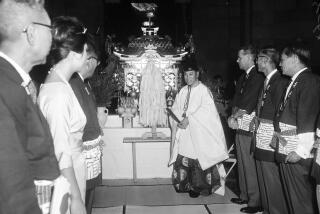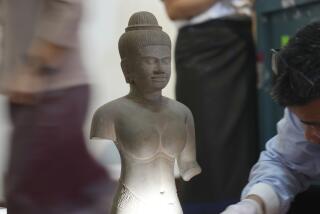Two Thai artifacts in a San Francisco museum were stolen. Now, they’re on their way home
The intricately carved sandstone slab immediately caught the eye of archaeologist Tanongsak Hanwong.
He was conducting research for his doctorate at Burapha University in Thailand when he found an article about two Thai antiquities at the Asian Art Museum of San Francisco, one featuring the Hindu and Buddhist god Yama seated on a buffalo over a Kala monster face motif.
The image looked exactly like one he had studied in a college class decades ago, a black-and-white slide photographed in 1959 at Prasat Nong Hong, a temple in northeastern Thailand. Tanongsak remembered it because it was unique: Yama, lord of death, rarely decorated Khmer temples in Thailand.
A second architectural lintel also was found in the museum’s online records. Both came from temple sites that Thailand had registered in the mid-1930s as national ancient monuments. They were protected property.
Which raised the question: What were the two 1,500-pound stone lintels doing in an American art museum?
It’s no secret that some of the Khmer civilization’s most significant artifacts end up outside Cambodia and Thailand, often through unscrupulous channels.
In 2008, federal agents raided four Southern California museums, including the Bowers Museum in Santa Ana and the Los Angeles County Museum of Art, after investigators traced the smuggling of Bronze Age artifacts from the Ban Chiang archaeological site in Thailand to a tax fraud scam involving museum donations.
Two decades before that, the Art Institute of Chicago returned a lintel that had disappeared from the Phanom Rung temple in the 1960s.
And the Asian Art Museum’s first benefactor, Avery Brundage, relinquished two stolen Khmer objects, including a lintel that was returned to Thailand in 1970.
“The next time you go into a museum, see how many antiquities are hacked off at the feet or the head, how few can be pinpointed to a specific location,” said Tess Davis, executive director of the Antiquities Coalition, a nonprofit organization that campaigns against the looting and trafficking of ancient art and artifacts.
When Tanongsak, who specializes in Khmer temple restoration and used to work for the Thai government’s archaeology division, discovered the two lintels in the San Francisco museum, he focused his efforts on bringing them back to Thailand.
The 61-year-old started an online campaign in 2016 to educate the public and push for the repatriation of stolen Thai antiquities, he said through an interpreter.
As Tanongsak’s cause gained media attention and momentum, several Thai village leaders joined the campaign, eager to see nearby historical sites restored.
A Peace Corps member based in Thailand emailed the San Francisco museum in August 2016 to say how much the lintels’ return would mean to locals. The Thai consul general in Los Angeles inspected the artifacts one month later and asked the museum for their return, but didn’t hear back.
Thai officials reached out to the U.S. government in May 2017 and organized a formal Thai repatriation committee that included Tanongsak a month later.
That’s when the Department of Homeland Security got involved.
In the art world, an object’s legitimacy depends on its provenance — where it came from and how it has changed hands over time. Good provenance ensures that the piece has entered the art market legally.
When Homeland Security entered the fray over the lintels, the first thing investigators did was subpoena the museum’s records.
Documents showed the two lintels had been on display at the Asian Art Museum since the late 1960s and were deeded to the city of San Francisco in the 1970s by Brundage. In 1959, the Chicago construction tycoon and former International Olympic Committee president started transferring the approximately 7,700 Asian antiquities he had amassed to the city with the condition that it build a museum to house his collection.
In 1966, the same year the Asian Art Museum opened, Brundage bought the Nong Hong lintel from a London auction house for $15,000, according to museum records.
He bought the second lintel, a piece of Prasat Khao Lon, on discount for $8,000 from a French dealer in 1968. A conservationist’s report noted shortly after the lintel arrived, museum employees dropped it during installation, breaking it into three pieces. The lintel had to be refurbished with metal pins and epoxy, a repair job that required additional work when the metal started to rust.
Every part of the lintels’ journeys — from auction house to San Francisco museum, by steamship and truck — was surprisingly well documented.
But the provenance trail stopped there. No prior sales receipts nor stamped Thai export licenses show how the lintels came into the art dealers’ possession, never mind how they left Thailand.
Brundage worried about the legitimacy of some of his purchases after the Thai government informed him in a 1967 letter that he had acquired two stolen objects: a bronze sculpture purchased from the same British dealer from whom he’d bought the Nong Hong lintel the year before, and a separate lintel from another seller.
“We have just received a letter from the Thai Government that a Thai lintel we have (not from you) has been stolen and they want it back,” Brundage wrote to the art dealers. “Please let us have the benefit of your views on this subject.”
The British dealer responded: “I am glad to say as far as I know, I have never handled anything stolen and I do try to guarantee this as much as possible.” He then reassured Brundage that the stolen bronze piece “came from the Thai-Cambodian border and as such, can be played either way.”
The second dealer, from France, passed the responsibility of legal provenance on to the exporter, then emphasized that the Khmer objects he had previously sold to Brundage were of “Cambodgian origine.” Brundage would again use the French dealer to purchase the purloined Prasat Khao Lon lintel the following year.
Fifty years later, Thailand provided the U.S. government with an abundance of information to back up its claim that the two lintels in the San Francisco museum’s collection were stolen.
The Thai government showed that it had customs laws for exporting cultural items dating to 1926. In the early to mid-1930s, it outlined laws to protect ancient sites, objects of art and antiquities, and registered hundreds of sites as national monuments under government protection. The two temples from where the lintels came are among those registered sites.
The temples were surveyed in 1959 and 1960 by the Fine Arts Department of Thailand’s Ministry of Culture.
The lintel repatriation committee, building off Tanongsak’s research, compiled reports using the department’s surveys. Side-by-side comparisons of the museum catalog and survey photos of both lintels taken in situ showed they were a match, down to their dimensions and visible wear and tear.
The committee even found correspondence between Brundage and the Thai government dating to the 1960s. The hole-punched letters, watermarked with a Thai seal and found in government archives, detail his bid to keep the stolen lintel and bronze statue. After expressing shock the lintel he had purchased “quite innocently” was stolen, Brundage proposed that it stay on display at the San Francisco museum, calling it a “wonderful advertisement for your country and it’s culture.”
The Thai government thanked Brundage for his offer but said it “would be happier if it did not involve theft and mutilation of our monuments.”
What the committee did not find were documents showing the Thai government had signed off on the removal of either lintel from the temples, much less the country, said Disapong Netlomwong, the senior curator at the National Museums of Thailand, who is also on the repatriation committee.
“Without this one thing, the museum cannot prove that the objects were correctly taken out of the country,” Disapong said.
Robert Mintz, the deputy director of the Asian Art Museum, said the museum has no idea how the lintels left Thailand. Instead, the facility makes the “general presumption that those dealers were not shady, but selling works legally to Mr. Brundage,” he said.
Most Thai and Cambodian museum objects don’t have those kinds of certificates, Mintz said. “I’m not sure that that’s evidence for any kind of theft of the objects. It’s a lack of evidence of legal removal.”
The museum didn’t know the lintels came from protected sites until the U.S. government intervened in 2017, Mintz said.
Initially, Homeland Security investigators said they planned to take the lintels into custody through an administrative forfeiture, but after months of negotiations with the museum, they called on the Department of Justice to expedite the case and represent Thailand.
It would take more than three years of government intervention before the dispute with the museum was settled. In October 2020, shortly after the museum announced it would start releasing the two lintels from its collection, the U.S. attorney’s office in the Northern District of California filed a civil forfeiture complaint against the museum, which agreed in February to return the artifacts to Thailand.
On Tuesday, the Asian Art Museum will hold its final vote to complete the de-accessioning process and turn the lintels over to Homeland Security soon after.
Museum spokesperson Zac Rose said by email March 1 that the museum doesn’t know of any other works in its collection that have questionable provenance, but “we are always continuing to study the histories of objects we interpret for the public.”
The back-and-forth legal drama over an Impressionist masterpiece that hangs in a Spanish museum has seemingly come to the end of the road for a San Diego family, which is left with nothing to show for their decade-long battle to reclaim the artwork they say was seized from them by Nazis 80 years ago.
Before the lintels were gouged out from their brick facades, they — and the deities they called on — were meant to protect the temples from malevolent spirits, a task they oversaw for nearly 1,000 years.
After the lintels are returned to Thailand, they will be exhibited at the Bangkok National Museum for several months, Disapong said.
While the repatriation committee hasn’t decided whether the lintels should be reinstalled permanently atop their original temple entrances, given the risk of damaging or losing them again, Tanongsak hopes they will be returned to their original settings. It’s his firm belief that the artifacts be appreciated in their natural environment. That way, those in the nearby villages can feel attached to their cultural heritage.
Another option is to display them at the nearest regional branch of the national museum, Disapong said.
Regardless of where the lintels end up, Tanongsak said they will add to the understanding of Khmer culture.
Tracing the flow of Khmer art throughout the region has been a central tenet of his work. By studying the materials, carving styles and techniques in the Nong Hong and Khao Lon lintels, archaeologists might be able to connect those and other temples, Tanongsak said.
“Khmer civilization doesn’t just belong to Cambodian people or to Thai people,” he said. “It’s a shared heritage.”
The repatriation committee says it has more work to do. The group has scores of other objects it wants returned to Thailand, Disapong said. Committee members are busy documenting provenance for those artifacts.
“In what world, other than the art world, is it so acceptable to buy stolen goods?” said Davis of the Antiquities Coalition.
Collectors and museums that “bury their heads in the sand, thinking this issue will go away, are actually limiting their options,” she said.
Sometimes countries want cultural objects repatriated. Other times, they’re happy with a public acknowledgment of the theft or will consider a long-term loan of the artifacts.
“It’s not often that we have an opportunity, as individuals or institutions, to right some of history’s wrongs,” Davis said. “It’s never too late to do the right thing.”
More to Read
Sign up for Essential California
The most important California stories and recommendations in your inbox every morning.
You may occasionally receive promotional content from the Los Angeles Times.












